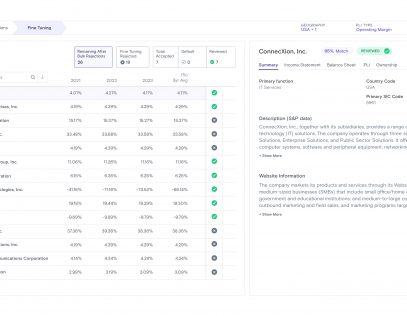There are a million reasons to prepare contemporaneous transfer pricing documentation. First, solid documentation is the key to transfer pricing compliance. Next, even imperfect documentation can offer penalty protection if it’s prepared contemporaneously. From the tax authorities’ point of view, putting the effort in shows that taxpayers are willing
to cooperate with authorities and are prepared to answer questions. Comprehensive documentation saves time and money during audits, too, because there’s no need to go to the ends of the earth to gather information—it’s already there. Many times, those goodwill efforts can inspire tax authorities to minimize not only penalties, but adjustments, too.
If that sounds like a warm and fuzzy depiction of a transfer pricing landscape that is at best, uncertain, well, it is. BEPS Action 13 has turned tax authorities on to not one, not two, but three tiers of documentation. Taxpayers must provide tax authorities with even more information to audit. More countries are looking to capitalize on transfer pricing as evidenced by an increase in resources in tax administrations and more country-specific requirements, unique laws, which can trip up the most well-intentioned taxpayers in terms of compliance. Let’s not forget the fact that tax authorities share information between jurisdictions, making taxpayers vulnerable to more adjustments—if a taxpayer is in deep with one tax authority, it’s probably in deep with another. And then there’s the reputational risks taxpayers can face if touchy information goes public. And we haven’t even talked about how varying tax treatments by jurisdictions and the courts can leave taxpayers teetering precariously between acceptable markups and attention-grabbing year-end adjustments. The truth is, transfer pricing documentation can help you navigate an ocean of uncertainty—in fact, it’s your only lifeline. Solid documentation puts you in a proactive position. Transfer pricing documentation offers an understanding of the businesses as a whole, not just at the entity level. And we can’t emphasize this enough: It can minimize penalties and adjustments. But given that a local file alone is roughly 100 pages, and a master file hovers around 50, how can tax managers, who we’re guessing may have other responsibilities, gather enough of the right information to appease tax authorities?
“Transfer pricing documentation can minimize penalties and adjustments.”
So Many Types of Documentation!
What do we mean when we say, “transfer pricing documentation?” Well, there’s the OECD’s recommendation of BEPS Action 13, which advises tax administrations to require a master file, a local file, and a country-by-country report. The master file, of course, is about the group and it offers a big picture of the multinational company, as opposed to one particular entity. The local file is prepared by the local entities, and it contains information about the local enterprises and their specific transfer pricing transactions. Then there’s the country-by-country report, which describes the group’s high-level financial and economic positions. The country-by-country report is the gateway to tax transparency, as reports are shared between tax authorities. The authorities in most countries require some form of BEPS Action 13, though they may add unique variations—like Italy’s master file structure or Australia’s master-local file combination. Generally speaking, though, the information required is the same. Some countries add on to these reports requiring transfer pricing-specific returns, like Poland’s TP-R. These returns focus on local transfer pricing transactions and though filed with tax administrations, they stand apart from income tax returns. Some countries require the local taxpayer to fill out transfer pricing questionnaires, like New Zealand. Other countries may issue them on an ad hoc basis. Transfer pricing-specific questions may also be required on the corporate tax return. Whatever the case, the taxpayer must meet all country-specific requirements to stay in compliance.
“The country-by-country report is the gateway to tax transparency, as reports are shared between tax authorities.”
Detective Work
There’s a lot riding on transfer pricing documentation and most tax managers are not moonlighting as investigative reporters. So, how can you go about collecting information concrete enough to satisfy tax administrations? Start with the big picture: The business and corporate overview. Here, tax authorities are looking for an overview of the group’s business and business strategies. They’ll want to see how the company is organized, the management structure, and also economic and legal conditions that may have impacted the business. Information about restructurings and competitors are also useful to tax authorities, as it presents a comprehensive view and also some context about the industry.
Tax managers may have to learn to be comfortable outside the tax department. Knowing and presenting information about the group requires ongoing discussions with business executives and strategy leaders. Tax executives will need to access annual reports, financial statements, legal documents, even headcount reports. Building bridges into the business, however, has its own rewards: The company can be made aware of business interactions that have transfer pricing implications before they happen, a huge advantage for multinational companies.
Local and master files include functional and operational profiles—meaning a description of intercompany transactions, the main value drivers of the business, the roles each entity played in intercompany transactions, and the transaction amounts. The functional analysis drives the rest of the documentation—once you finish this analysis, about 80% of the documentation is complete. To get such an intimate view of the company, tax managers will have to conduct functional interviews with the business leaders, including the CFO, the CEO, and perhaps, human resource and engineering managers. Basically, get in touch with leaders who know the roles of each team. In fact, functional interviews are recommended annually, as so much of profit allocation depends on the function of each entity. If tax executives need to find out about a manufacturing entity, ask detailed questions about that part of the business. “What materials or partly finished goods are purchased? From whom are they purchased? Who performs the purchasing function?”
If the interview is about a research and development function, then tax executives might ask, “What types of R&D projects are carried out here? Where are products designed? How important is the development of patents?”
Like functions, transfer pricing documentation will also require information about assets and risks. Which entity in the multinational group contributes which assets to the business? Transfer pricing managers will need to know who owns manufacturing equipment, warehouse space, computers, and, of course, intellectual property. Which entity owns patents? Trademarks?
Risks are important, as well. Find out which entities are assuming risks as well as the types of risk. Does one company loan money to another? That entity then is absorbing credit risk. A distributor who owns inventory that could become obsolete may assume inventory risk. The bigger the risk, the bigger the reward.
“Tax managers may have to learn to be comfortable outside the tax department. Knowing and presenting information about the group requires ongoing discussions with business executives and strategy leaders.”
Work Smart (Not Hard)
It’s always a good idea to keep last year’s transfer pricing files organized and stored in a central place. Yes, they’ll help answer to tax authorities, but they’ll also provide a much-needed jumping-off point in terms of documentation. Last year’s transfer pricing study can be instrumental in updating this year’s report. Often much of the business information doesn’t have to change, it’s just the financials that require updating. Having the report to refer to can save taxpayers a lot of work.
Advance pricing agreements, cost-sharing agreements, tax rulings, and transaction-specific documents, like an election of services cost method document, could provide key information, as well. If any agreements have an impact on transfer pricing transactions, taxpayers will want to know what those impacts are before tax authorities do.
Countries have their own specific requirements that may or may not align with the OECD’s recommendation of a master and local file, plus a country-by-country report. Taxpayers want to research what is expected from each country where the company has operations and ensure that it’s meeting those regulations. There may be special rules about where benchmarks should be located—some tax administrations, like Malaysia, only accept local comparable companies, the thinking being that those companies represent local market conditions best. Other country-specific requirements may come into play, as well: China, for example, requires that companies disclose value chain analyses, information that can be extracted from the functional analysis. Italy requires that companies record all of their intercompany transactions on the master file. Those functional interviews reveal a lot about local markets as well as the group.
Tax authorities want to be assured that reasonable judgment came into play when setting arm’s-length transfer prices. So, providing the information that helped taxpayers arrive at an arm’s-length result is important. Taxpayers should review third-party agreements and financial information, including budgets and projections for transactions that are soon to take place. Basically, any documents that can further support the arm’s-length result is advantageous.
“Taxpayers want to research what is expected from each country where the company has operations and ensure that it’s meeting those regulations.”
The Rules
Though tax managers well know that transfer pricing documentation has to be compiled every year, few strategize throughout the year to get it together. Incorporating information-gathering techniques into the role of the tax department only makes the job easier. For example, conducting functional interviews doesn’t have to be a once-a-year thing. Send questionnaires and surveys regularly. Make meeting with department heads part of business-as-usual. Facts and circumstances change all the time—2020 is certainly proof of that. Tax managers don’t have to encounter those changes by surprise on the back end, they can know about them as changes occur. In fact, if changes to the business model have transfer pricing consequences, then tax managers can warn the C-suite and strategize together from the outset.
There’s a reason multinational companies put so much time and effort into intercompany agreements: These legal documents are created to protect the company. Yet it’s surprising how many companies file them—and then forget about them. Intercompany agreements include key functions and risks assumed by related parties and provide excellent supporting documentation—if they’re maintained, updated, and reflect the true nature of the business. Treat them like third-party contracts, meaning review and update them regularly. Submit them with transfer pricing documentation—failing to do so is a red flag for tax authorities.
Next, perform a value chain analysis on an annual basis and see how the business is evolving. By doing so, tax managers can understand the business’s profit drivers as well as the principal contributions to the value each entity provides. A value chain analysis is often requested during audits and in some countries, it’s required to be included with a master and local file.
The more proactive taxpayers are, the better off they are. And that doesn’t have to begin with transfer pricing documentation—it starts with transfer pricing planning. Setting transfer prices can be part of the budgeting process from the get-go. Learning there’s a problem at the end of the year puts taxpayers in a defensive position, which is not advantageous when you’re dealing with tax authorities.
Taxpayers often review transfer pricing adjustments and make end-of-the-year true-ups, but the reality is that pricing reviews don’t have to wait for the end of the year. Reviewing transfer prices throughout the year lets taxpayers avoid large adjustments at the end, which is one less red flag for tax authorities. Why stop there? Build a transfer pricing documentation process and centralize it. If one entity has intercompany transactions with entities around the globe, then that entity could be responsible for transfer pricing documentation for the group. Not only does it alleviate the burden for tax departments throughout the group, but it guarantees consistency throughout documentation—a key element in avoiding inquiries and audits.
Deadlines are another issue for tax departments. Keep track of deadlines for corporate tax deadlines. In most countries, documentation should be prepared, not submitted, by the time of the corporate tax return, so those dates have meaning for transfer pricing, as well.
Above all, always seize an opportunity to be proactive. Develop strategies for meetings, monitor information, and make sure documents reflect the reality of the business today. With advanced planning, taxpayers can avoid audits altogether. Even if one should occur, if excellent transfer pricing practices are embraced throughout the year, multinational companies can strategize for it—instead of just scrambling to gather information that should have already been documented in the first place.
“Reviewing transfer prices throughout the year lets taxpayers avoid large adjustments at the end, which is one less red flag for tax authorities.”









